 |
|
|
| |
| Sedimentary structures
| Last Updated • March 3, 2014 | |
HORIZONTAL BEDDING
| Horizontal Bedding alternating shales and sandstones (trees for scale) |
 © Alessandro Grippo |
Cedar Breaks
National MonumentUtah, USA |
| Horizontal Bedding alternating shales and sandstones |
 © Alessandro Grippo |
Capitol Reef
National ParkFruita, Utah, USA |
| Horizontal Bedding in fresh sediment
(mature, quartz beach sands) (footprints for scale) |
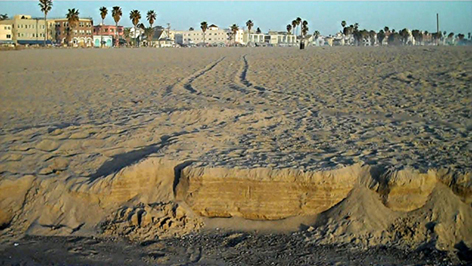 © Alessandro Grippo |
Venice Beach Venice,
Los Angeles, California |
CROSS BEDDING
| Cross Bedding Large scale cross beds |
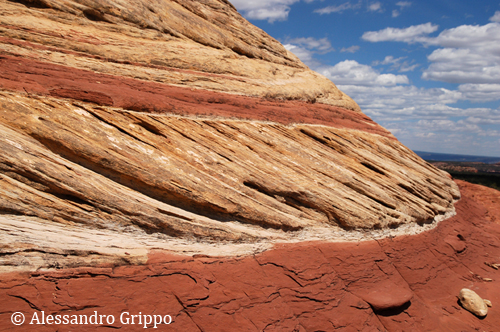 © Alessandro Grippo |
San Juan County Utah, USA |
| Cross Bedding Large scale cross beds
from aeolian (wind)
environment |
 © Alessandro Grippo |
Checkerboard Mesa Zion
National Park Utah, USA |
| Cross Bedding a detail from
the previous image |
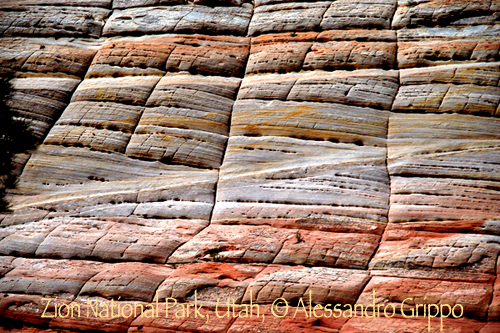 © Alessandro Grippo |
Checkerboard Mesa Zion
National Park Utah, USA |
| Cross Bedding Large scale cross beds
from aeolian (wind)
environment |
 © Alessandro Grippo |
The Wave Vermillion Cliffs Arizona, USA |
| Cross Bedding Large scale cross beds,
detail (width of image ca. 10 cm / 4 inches) |
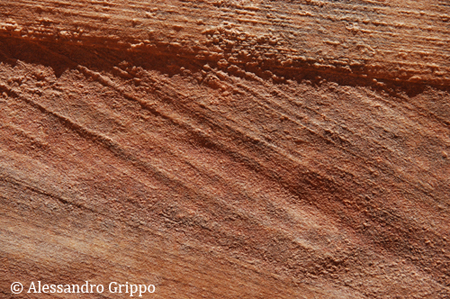 © Alessandro Grippo |
Capitol Reef National Park Utah, USA |
| Cross Bedding a side view of cross beds
shows the basal contact
with horizontal beds at the front of the structure
(tabular cross bedding) |
 © Alessandro Grippo |
Cadiz, California, USA |
Cross Bedding:
a front view of cross beds
shows curvy "packets" of beds
(trough cross bedding) |
 © Alessandro Grippo |
Cadiz, California, USA |
Cross Bedding:
a lateral view of cross beds:
climbing ripples within a Bouma sequence
in turbidite deposits |
 © Alessandro Grippo |
Palazzuolo sul Senio, Firenze, Italy |
RIPPLES (SYMMETRICAL and ASYMMETRICAL)
| Ripples wind-originated ripples
in red (oxidized) sands (coin for scale) |
 © Alessandro Grippo |
San Rafael desert Green River, Utah |
Ripples
(asymmetrical ripples)these ripples form
when water flows in one direction only |
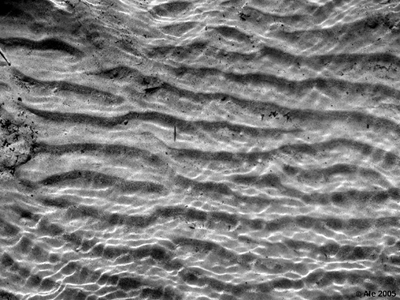 © Alessandro Grippo |
Snake river Alpine Junction, Wyoming |
Ripples
(symmetrical ripples)these ripples form
when water flows back and forth |
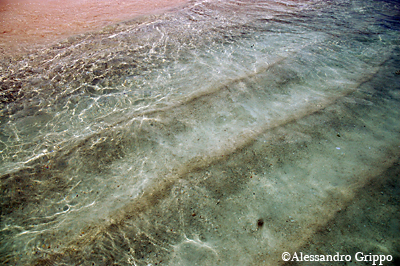 © Alessandro Grippo |
Atlantic Ocean Nassau, Bahamas |
Ripples
(symmetrical ripples)these ripples form
when water flows back and forth |
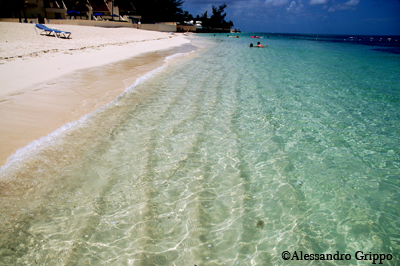 © Alessandro Grippo |
Atlantic Ocean Nassau, Bahamas |
Ripples
(symmetrical ripples)these ripples form
when water flows back and forth |
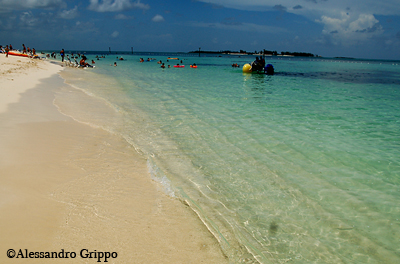 © Alessandro Grippo |
Atlantic Ocean Nassau, Bahamas |
Ripples
(symmetrical ripples)This sandstone shows
evidence of an ancient beach |
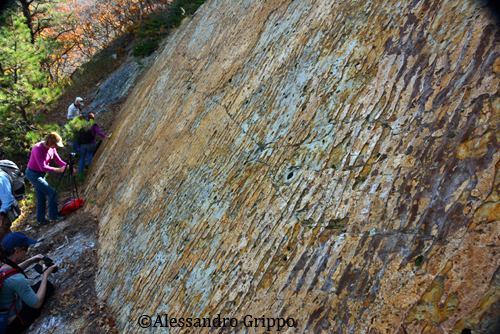 © Alessandro Grippo |
Dakota Sandstone (Lower Cretaceous) Littleton Colorado, USA |
Ripples
(asymmetrical ripples)formed by a receding tide:
the ebb flow reshapes the sand
|
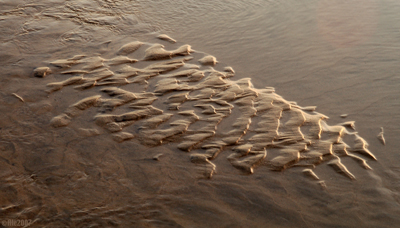 © Alessandro Grippo |
Point Dume, California, USA |
Ripples:
asymmetrical ripples
formed by a receding tide:
notice the steep side (downcurrent)
and the gentle side (upcurrent);
also notice the gravel collecting in the ripples' trough |
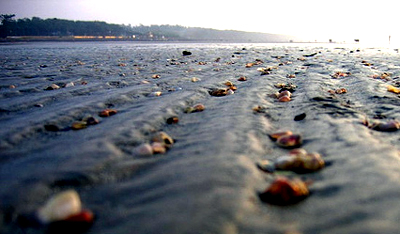 © unknown, from Flickr |
Indian Ocean, Bangladesh |
MUD CRACKS
Ripples and Mud Cracks:
asymmetrical ripples
formed by wind action
have been covered by water
that deposited a thin veil of mud;
desiccation of mud caused cracking and peeling(coin for scale) |
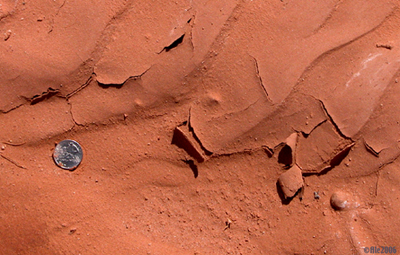 © Alessandro Grippo |
Canyonlands National Park, Utah, USA |
Mud Cracks
with Raindrop Impressionsdesiccation caused mud to shrink and crack;
raindrops left an impression
on the polygonal surfaces (hammer for scale) |
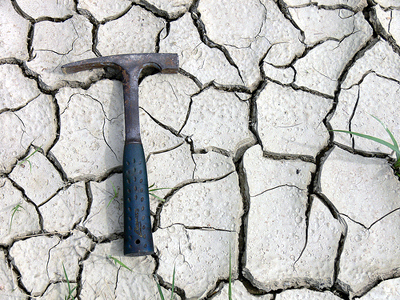 © Andy Duncan |
Texas, USA |
| Mud Cracks a desiccated thick mud layer
originated very big and deep
mud cracks
(Jeep for scale) |
 © Alessandro Grippo |
Lake Powell
dry bedHite Crossing Utah, USA |
| Mud Cracks mud flows from a mud volcano
often change direction.
The abandoned flows quickly dry up and crack.
(height of volcano: about 3 m, or 10 ft) |
 © Alessandro Grippo |
Mud Volcanoes Field Nirano Modena, Italy |
Fossil
Mud Cracksafter desiccation,
cracks were filled with sand
and thus preserved
(coin for scale) |
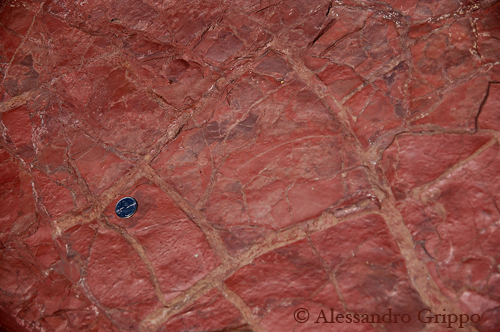 © Alessandro Grippo |
Glacier
National ParkMontana, USA |
GRADED BEDDING
Turbidites:
The lower part (a-b-c) of a Bouma sequence:
the interval a is constituted by massive bedding;
the interval b by parallel, horizontal lamination;
the interval c by cross-bedding and convolute lamination.
(coin for scale) |
 © Alessandro Grippo |
Palazzuolo sul Senio, Firenze, Italy |
STROMATOLITES
Living Stromatolites:
algal mats trap
sediment particles
that force the algae
to outgrow through them;
layer after layer
stromatolites are slowly built |
 © Will Bakali |
Hamelin Pool,
Shark Bay, Australia |
Fossil Stromatolites:
notice the growth layers;
stromatolites are useful
both as
environmental indicators
(they require warm waters
and absence of predators)
and geopetal indicators |
 © b. centley |
Helena, Montana, USA |
Fossil Stromatolites:
these stromatolites are shown
still embedded
in surrounding sediment,
thus providing
a 3-D view of their structure
(coin for scale) |
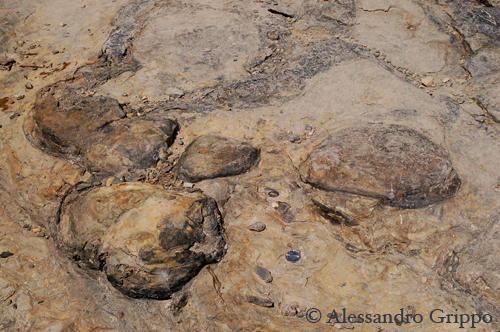 © Alessandro Grippo |
Glacier National Park, Montana, USA |
Fossil Stromatolites:
a view from above
of one of the stromatolites
from the previous locality
(coin for scale) |
 © Alessandro Grippo |
Glacier National Park, Montana, USA |
Fossil Stromatolites:
a cut-through section
of one of the previous stromatolites,
showing a characteristic
mushroom-like shape
(coin for scale) |
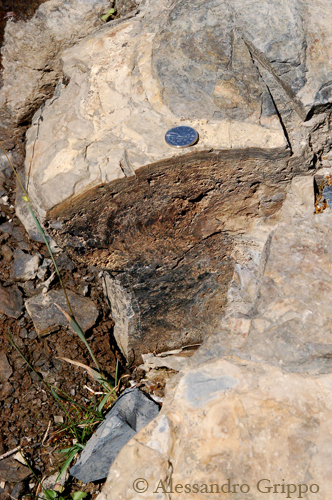 © Alessandro Grippo |
Glacier National Park, Montana, USA |
Fossil Stromatolites:
a close-up detail
of the previous stromatolite,
showing details of the growth layers
(coin for scale) |
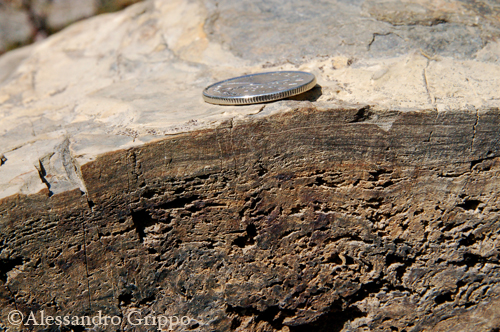 © Alessandro Grippo |
Glacier National Park, Montana, USA |
Fossil Stromatolites:
a view of a stromatolite patch
along a road cut
(vertical scale is about 5 m,
or about 15 ft)
(coin for scale) |
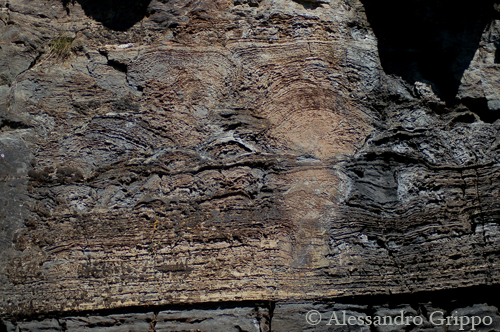 © Alessandro Grippo |
Glacier National Park, Montana, USA |
Fossil Stromatolites:
a detail of the growth layers
from the previous location
(coin for scale) |
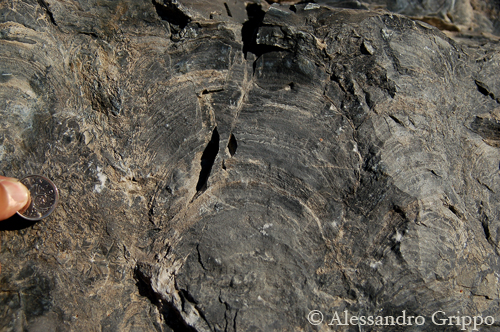 © Alessandro Grippo |
Glacier National Park, Montana, USA |
BIOTURBATION
Bioturbation:
biologic activity
at the ocean bottom
erases bedding;
bioturbation is an indicator of
optimal conditions for life,
that is, abundance of oxygen |
 © Alessandro Grippo |
Point Mugu,
Ventura county, California, USA |
Bioturbation:
a detail
from the previous image
|
 © Alessandro Grippo |
Point Mugu,
Ventura county, California, USA |
Bioturbation:
another detail, with scale(purple pen for scale) |
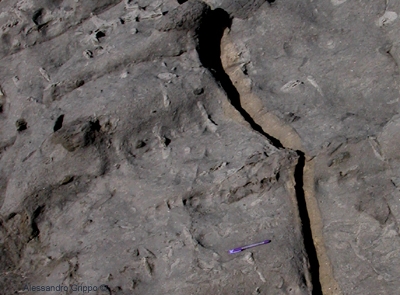 © Alessandro Grippo |
Point Mugu,
Ventura county, California, USA |
Bioturbation:
Daemonhelix,
or a "devil's corkscrew"(as exposed in a glass case
at the National Park Visitor Center) |
 © Alessandro Grippo |
Agate Fossil Beds
National Monument,
Nebraska, USA |
OTHER FEATURES
Colored Parallel Beds:
These alternating layers of
limestone (whitish)
and shale (reddish),
from a core drilled
in Cretaceous sediments,
show continuously changing
oxygen conditions
at the bottom of the ocean
at the time of their sedimentation(centimeter scale on the left) |
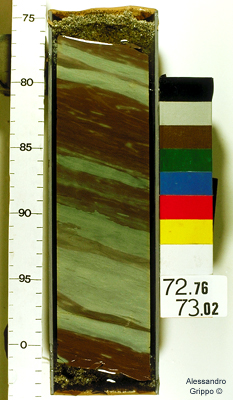 © Isabella Premoli Silva, Alessandro Grippo |
Piobbico core,
Pesaro - Urbino, Italy |
Folds (tectonic structures):
tectonic activity can
cause folding of
sedimentary layers;
this picture shows why
layers can be found
upside down
and geologists need a geopetal indicator |
 © Stevie D - Earthwatcher |
Cornwall,
England, United Kingdom |
Rock Colors Diagram:
A diagram introducing to the
relationships between lithologies
and different oxygen conditions) |
 © Alessandro Grippo |
modified from
Alessandro Grippo et al.,
SEPM Special Publication
volume 81, (2005)
Tulsa, Oklahoma, USA |
| all photos © Alessandro Grippo, except where indicated |
Back to Top | Back to Home Page
© Alessandro Grippo, 1994-2010
Los Angeles, California
| |

